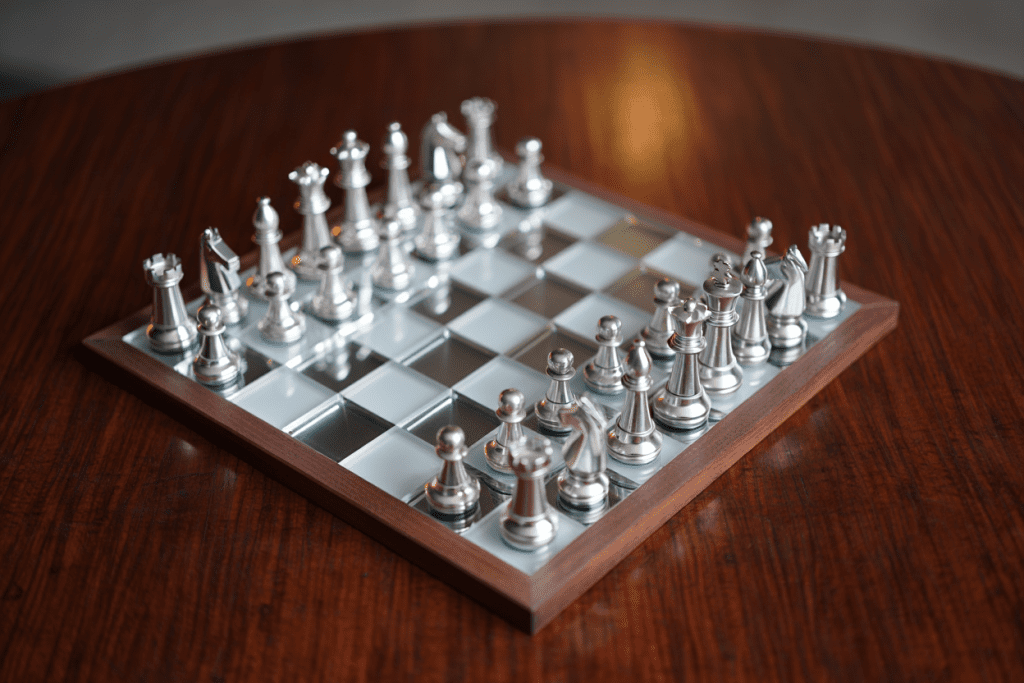The Origins of the Chess Board in Ancient India
The history of the chess board begins in ancient India, around the 6th century, with Chaturanga, a game symbolizing the four divisions of the army. Played on an 8×8 chess board, it became the blueprint for every version of the game that followed. Early boards were carved from wood, stone, or painted on fabric, serving as portable battlefields for the intellect.
When the game spread through Persia, it became Shatranj, and the Persian chess board reflected a new level of refinement. Although most boards were monochrome, Arab artisans began experimenting with alternating tones for better visibility. This small design change marked the first step toward the familiar pattern every chess board carries today.
Islamic Golden Age: Geometry and Artistry
During the Islamic Golden Age (8th–13th centuries), chess reached its first great cultural peak. Islamic artisans transformed the chess board into a study in geometry, creating inlaid patterns with bone, ivory, and precious woods. Because human figures were forbidden in Islamic art, these boards emphasized mathematical precision and abstraction.
The chess board became an object of aesthetic beauty as much as a tool for strategy. Boards of red and green squares or natural wood tones demonstrated both luxury and logic. Some of the finest examples still exist in museums, where their craftsmanship stands as proof of the game’s early prestige.
Chess in Medieval and Renaissance Europe
By the 10th century, the chess board had made its way to Europe, where it captured the imagination of monks, nobles, and scholars alike. Europeans adopted the alternating black and white squares that came to symbolize the eternal tension between opposing forces—light and dark, good and evil.
During the Middle Ages, the chess board became a fixture of courtly life, often built into tables or painted onto gaming chests. In the Renaissance, it evolved again—luxurious versions with maple, ebony, and ivory reflected the wealth and artistry of noble households.
As Europe expanded its influence, the chess board spread across continents. Russian artisans crafted lacquered boards, Indian masters carved them from sandalwood, and in China, chess took on entirely new forms, adapting the board’s idea of symmetry into xiangqi.
The Modern Chess Board: Standardization and Symbolism
The 19th century ushered in the era of modern chess, with tournaments and clubs demanding uniform standards. In 1849, Nathaniel Cook and John Jaques of London introduced the Staunton chess set, paired with the first fully standardized chess board—a grid of 64 alternating light and dark squares, usually maple and walnut.
This version of the chess board balanced clarity and elegance, complementing the carved Staunton pieces perfectly. The board’s borders gained letters and numbers, enabling players to record moves in the new algebraic notation. From this point onward, the chess board was not just a playing surface—it was a universal language of strategy.
Industrialization democratized the game. Mass production made the chess board affordable, bringing it into homes, cafés, and classrooms around the world. Simple cardboard and vinyl versions became staples of education, while artisans continued producing ornate boards from marble, mahogany, and rosewood for collectors and championship events.
The Digital Chess Board: From Table to Screen
In the 20th century, technology redefined the chess board. The first computer chess programs displayed crude text grids, but by the 1990s, digital rendering allowed players to experience photorealistic wooden boards and lifelike movement.
Today, millions play on online platforms such as Chess.com and Lichess, where the chess board has become virtual yet universal. Digital boards preserve the same 64-square geometry while offering new features—timers, analysis tools, and 3D visualization. The tactile pleasure of moving pieces has been replaced by the soft click of a mouse, yet the chess board’s role as the arena of strategy remains unchanged.
The digital chess board has, in a sense, returned the game to its roots—a mental contest existing beyond materials, focused purely on thought and precision.
A Modern Renaissance in Chess Board Design
Even in the age of screens, the physical chess board is experiencing a revival. Craftsmen and designers are reimagining it in modern materials—glass, steel, carbon fiber, and illuminated resin—while retaining the timeless balance of light and dark. Collectors seek boards that merge art and intellect, and contemporary architects display chess boards as design statements rather than mere game tools.
Museums now curate exhibitions that trace the chess board’s thousand-year journey, highlighting how this simple pattern has reflected every culture’s approach to art, mathematics, and competition.
Conclusion: The Eternal Grid of Strategy
The chess board stands as a masterpiece of minimalism and meaning. Across centuries, it has symbolized intellect, equilibrium, and the beauty of structured thought. From the battlefields of ancient India to the virtual tournaments of today, its 64 squares remain unchanged—a testament to humanity’s quest for order in chaos.
Whether carved in ebony, printed in vinyl, or glowing on a digital screen, the chess board endures as one of the most recognizable designs in history. It is not just a surface—it is the meeting point of art, logic, and imagination, forever challenging the human mind to think one move ahead.
